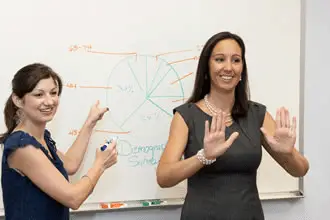One of the most common questions I am asked as an American Sign Language (ASL) interpreter is if ASL is universal. If I were to go to another country, would I be readily able to communicate with a Deaf person? ASL is primarily used in the United States, most of Canada, certain countries in West Africa, and is spread out in some areas of Asia and some island nations. While ASL may be used in some of these areas, many of these countries have their own indigenous signed languages. ASL may have been introduced when these countries were colonized, or brought over by missionaries. ASL was, in fact, derived from Langue des Signes Française (LSF) so it is linguistically very similar to French sign language.
While ASL is the accepted language of the Deaf in America, there are also regional dialects and variances that occur. Just like if a person from Texas were to travel to New York, they would notice differences in English like the speed, slang, or word choice. Think of the words soda, pop, and coke. While they all generally mean the same thing, saying, “I want a coke” in Indiana would mean you are ordering a Coca Cola. In Texas, saying, “I want a coke” would be followed up with, “Ok, what kind?”. These variances occur in ASL as well.
I had the unique opportunity of travelling to England and Wales and meeting a native user of British Sign Language (BSL). I was standing on a platform, waiting for my train to arrive and noticed two people signing to each other. I politely asked if they were using BSL, and they both enthusiastically answered yes. Unlike ASL, BSL uses two hands to fingerspell. I had taught myself the BSL manual alphabet before leaving for my trip just in case an opportunity like this would present itself. People would think that because English is the primary spoken language in the United States and England that their signed languages would be similar, but this couldn’t be further from the truth. One of the women knew ASL and BSL both, so she was able to interpret for me. It was an awesome and humbling experience to have to rely on an interpreter to be able to communicate with this Deaf woman using BSL. Seeing firsthand a native user of a different signed language was a great reminder of how intricate language is, and how knowing one does not mean you have even the slightest grasp of another.
-Stephanie Orcutt, ASL Interpreter


